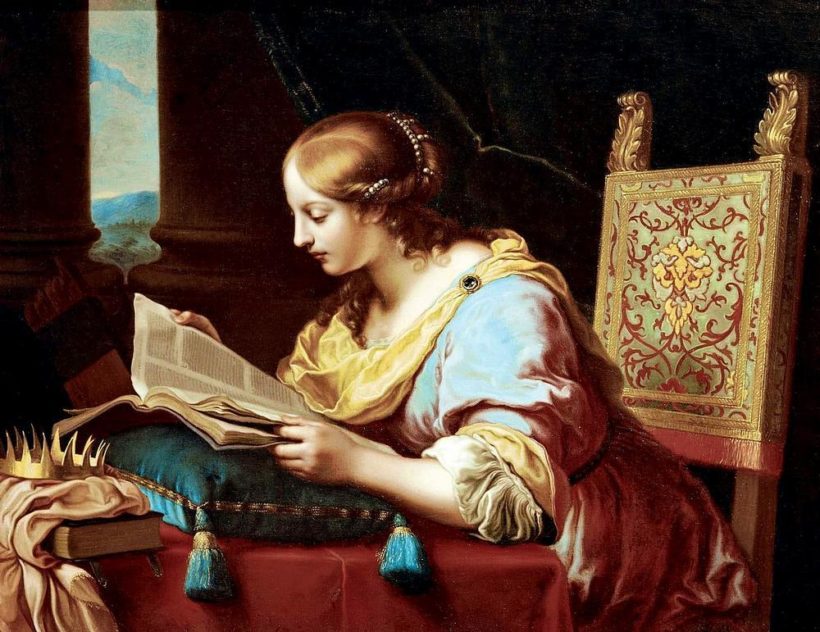Imagine you are living in southern Italy around the year 1115 AD, walking in a beautiful garden with an interesting woman who is talking and cutting plants as you go along. The Mediterranean sun pours over your head filling you with vitality and well-being. An ideal climate for growing the multitude of healing plants before you.
You embrace the delicious aromas, and this Trota woman describes to one of her female patients what they need. They return to the sun to pick some roses for the incredibly fragrant bouquet of plants that she will use in her work as a healer and teacher… (*)
By Horacio Mesón
“In the 11th and 12th centuries, medical ideas, research and observations were centred in the flourishing city of Salerno, Italy. Physicians from all over Europe and the Mediterranean world went there to learn. The city, located south of Rome, was a luxury as a commercial and agricultural centre.
The inhabitants of Salerno had an abundant supply of medicinal plants derived from their local crops. Other herbs from foreign trade, as well as resins, spices and minerals were an integral part of their medical system.
The medical school at Salerno during the 12th century was an informal community of teachers and students who developed formal methods of teaching and research. Founded around the year 1000, it was the first non-religious medical school.
Greek, Arabic and Jewish texts were freely studied. These texts reflected the diversity of Salerno’s population. Lombards, Greeks, Romans, Jews and North African Muslims, a fusion of cultures. The learned doctors of Salerno maintained high standards in surgery, in teaching anatomical techniques and animal dissection. They unified surgery and medicine. The school was closed by decree by Napoleon in 1811.
From the 11th to the 13th century, women in Salerno were allowed to learn and practice medicine alongside men. Licenses to practice medicine were granted by the state. For most of the women healers who practised medicine and midwifery in the Middle Ages, no written records have survived. In Europe women were excluded from formal medical education. One of the few exceptions was an Italian woman who was to be recognised as a healer, teacher and writer, not only during her lifetime, but also for centuries afterwards.
This woman was Trota, known as “the wise woman teacher”. We have no knowledge of personal details about her, such as her birth, her family and her death. Her practice is included in Salvatore de Renzi’s classical texts published in 1582 and 1589. Some of her manuscripts are in museums throughout Europe. The book, Practica Secundu Trotam, is known to include seventy-one remedies for all kinds of ailments, from gynaecological diseases and obstetrics to problems of the eyes, feet and spleen. She gives advice on how to treat a fever, a toothache or haemorrhoids and, of course, recipes for cosmetics.
“It is amazing that Trota learned to read and write Latin when most women in Salerno were married, had children and received very little education. She knew a lot about botany and this was revealed in her remedies. She was a skilled diagnostician who used all her senses. She dealt with pulse and urine analysis, as well as observation of the patient’s face and words. She also had the courage to study and to write down her results. An important book On the Treatment of Illnesses, written in the second half of the 12th century, by the seven leading physicians of Salerno, includes Trota, also verifying her knowledge”.
This quotation attributed to her explains the true motivation of her work: “Women, because of their modesty, do not dare to reveal the difficulties of their illnesses to a male doctor. Therefore, taking pity on their misfortunes, I began to study carefully the diseases that most frequently afflict the female sex”. This is why she chose to focus on gynaecology, obstetrics, cosmetics and skin diseases.
She used herbs and flowers and imported spices from India. We must certainly classify her as an aromatherapist, as almost all of her remedies involved aromatic substances. Trota’s remedies were much simpler than the recipes of Galen, who taught his students to be proud practitioners who treated their patients with superiority. Trota taught a gentle and sincere sympathy for sick patients, his medicine was very direct and more touch-oriented.
Her three books were merged into a single work that was very popular among European physicians, midwives and women in general. In the 1400s it was translated into Dutch, French, English and German. By 1500 there were six different versions of Trota’s collection. This book became one of the pillars on which medieval culture was built, being present in the libraries of physicians, surgeons, monks, philosophers, theologians and princes from Italy to Spain, and from Ireland to Poland.
Slowly the opportunities that opened up for Trota and her northern sister in the field of health, Hildegar of Bingen, were not to last. The door allowing women to heal in public closed at the end of the 12th century. The church emerged as the new authority in the world of medicine. Women were no longer qualified to study medicine and become teachers, even though Salerno was one of the last cities to oppose female education.
Trota represented the woman healer of the distant future. She showed confidence in her intuition, knowledge of science, awareness of suffering, sense of service, love of phytomedicine and capacity for compassion. Centuries afterwards, some magnificent examples of women healers would emerge: nurses, doctors, alternative health practitioners and midwives. Trota’s example and writings were an inspiration to all.
(*) The essential content of this article is taken from the book “Aromatherapy, awakening to healing fragrances” by Elizabeth Anne Jones, 2012, Editorial Antroposofica, Bs.










